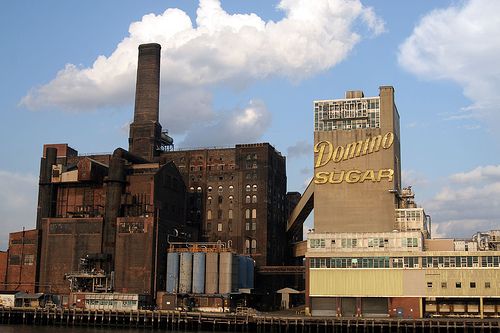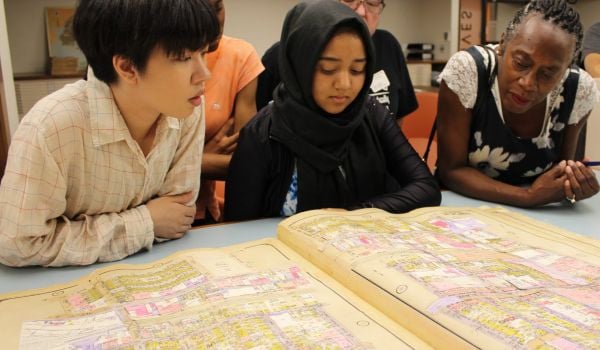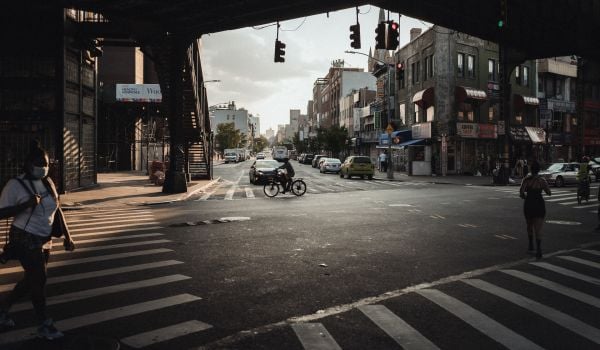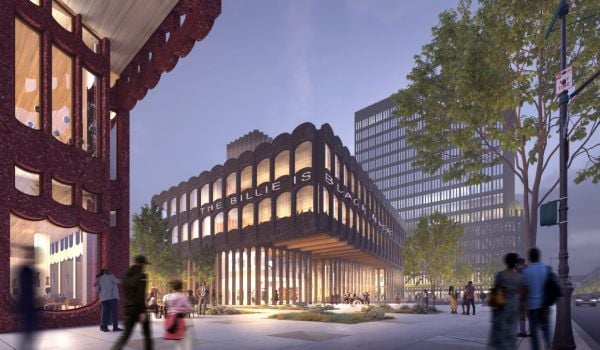Last week, New York’s Department of City Planning approved the plan for a new development on the Williamsburg waterfront at the old Domino Sugar refinery site. The new development will be an 11.2 acre mixed-income community with 2,200 residential units, commercial space, retail space, some sort of community center, and – don’t worry! – they’re going to keep the 40-foot Domino sign at the top of the building.
My initial reaction was one of disgust. Another condominium tower on the Williamsburg waterfront? Aren’t there already three vacant ones? According to a recent article on The American Prospect, if you add up all the vacant or nearly-vacant condominium buildings in Lower Manhattan, Downtown Brooklyn, Bushwick, and the South Bronx, you would find more than 600. That’s a lot of buildings. Last year, New Yorkers saw reports that gutter punks were taking up residence in vacant Williamsburg condos, and that a luxury Crown Heights building was re-purposed as a homeless shelter. Perhaps the developer is allergic to money, or something.
But my initial concerns about the “New Domino” project have nothing to do with the fact that I can’t fathom how it will generate a profit. Part of it is aesthetic. Condominium buildings have a tendency to be ugly, in my opinion. I’m not alone in this. Another part of my distaste for the project has to do with the disingenuous tip of the hat that it offers to the neighborhood’s industrial past by keeping the 40-foot Domino sign attached to the new four-story glass-and-steel extension they plan to build atop the renovated refinery building. This has always been a gripe I’ve had about New York. Trendy new businesses cannot help but name themselves for whatever working-class business used to exist at the same location. It has always struck me as being an inside joke that’s in poor taste, even though it always seems to pass for the opposite. On the one hand, it points out to older neighborhood residents that the neighborhood as they know it is gone except for in the form of brand-identity kitsch. To newer residents, it lets them know just how easy it is to make money off of them with these stabs at faux-authenticity. But I probably give this sort of thing too much thought.
Or maybe not. An op-ed/book report on Sharon Zukin’s Naked City: The Death and Life of Authentic Urban Places ran in the New York Post just the other day. Zukin’s book, which NAC reviewed in Issue 25, examines issues of “authenticity” and gentrification in five New York neighborhoods. Zukin argues that “gentrifiers” are motivated not only by cheap rents but also by a search for “authentic places”, which they end up destroying in the process of gentrification. The author of the piece in the Post, Julia Vitullo-Martin, sides with the “gentrifiers” in the end, because she thinks Zukin’s anti-gentrification recommendations for governmental intervention into renter’s markets would make New York’s economy stagnate so badly, we might as well turn back the clock a quarter century (not exactly an editorial $tance you might expect from the Po$t!).
Which brings me back to the New Domino project. Zukin and I most likely have the same issue with the proposal, and it probably has too much to do with the use of the Domino sign, and not enough about what is actually going to happen to Williamsburg’s Southside, should the project go through. These aesthetic considerations are made irrelevant when you consider the issue of affordable housing: the one thing that probably decides how “authentic” a neighborhood is, or can be. Turns out, one of the hallmarks of the New Domino plan is that 30% of its units – compared to the industry standard 20% – will be below-market. And well below market, at that. The Brooklyn Eagle reports that the plan calls for “100 units reserved for families with incomes of up to $23,040,” (Very Low Income) and “310 units reserved for families earning up to $46,080” (Low Income). Not only that, the project will also allow for public access to the waterfront, and it will add 274,000 feet of new retail and “community cultural facility” space to the neighborhood. And, in all honesty, it’s not that bad looking.
I don’t mean to suggest that we should all be totally sold on the New Domino project, though I imagine it will get all the subsequent approvals it needs from the City. I, too, wish that developers would just leave some places alone. But there is a lesson to learned from this decade of rapid gentrification and development in Brooklyn: that developers will not stop building in places people like me wish they wouldn’t. So, any builder that makes a genuine attempt to provide affordable housing and any sort of service to the neighborhood should be judged not for their affect on the neighborhood’s authenticity – as is, I suspect, the knee-jerk reaction – but on its functionality. If residents and advocacy groups take a stance against all development, they’re going to continue to lose. If they can tell the truly offensive from the not-really-offensive proposals, and take the small victories they can in a pro-development political climate, they might actually encourage the right kind of value-added development that helps a community’s bottom line, and not just the developer’s. One hopes that developers are looking for new business models these days. Maybe, though I’m very skeptical, New Domino can show some sort of middle way.
















